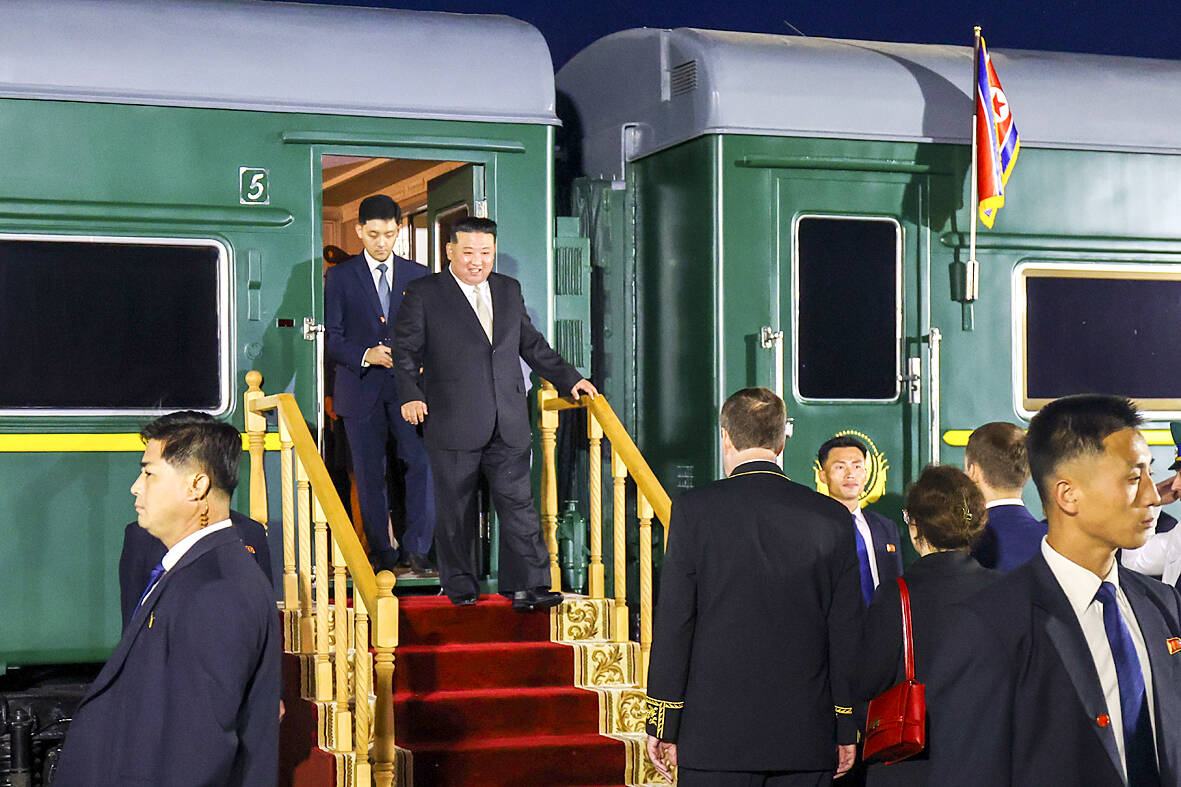Joe Biden has Air Force One; Rishi Sunak a fleet of RAF jets and helicopters. But when Kim Jong-un makes one of his rare journeys outside North Korea, he has an armoured train in which to while away the hours.
The North Korean leader’s dark green train crossed the Russian border on Tuesday in advance of talks between Kim and Vladimir Putin on supplying the Kremlin with munitions for the war in Ukraine.
The trip is Kim’s first outside North Korea since the COVID-19 pandemic forced the country to close its borders, and his second meeting with Putin since the leaders held talks in Vladivostok in April 2019.

Photo: AP
The summit will come at the end of a journey from the North Korean capital Pyongyang lasting an estimated 20 hours, during which Kim will have prepared and rested in luxuriously decorated carriages that moved at a snail’s pace through North Korea.
Kim does not reportedly share the fear of flying that forced his father, Kim Jong-il, to travel long distances exclusively by rail — he flew to his 2018 summit in Singapore with Donald Trump and to a meeting with the Chinese leader, Xi Jinping, the same year in the Chinese city of Dalian.
But the armored train, which includes bedrooms and a meeting room fitted out with wall-mounted lighting and reddish-pink leather armchairs, appears to be Kim’s preferred mode of transport. It took him 4,500km through China for his second summit with Trump, in Hanoi in 2019 — a journey that lasted two-and-a-half days.
Only a select few have seen the inside, including a Russian official, Konstantin Pulikovsky, who in his book Orient Express recounted fine-dining menus during a trip across Russia’s Far East with Kim Jong-il.
Passengers could choose from an eclectic range of dishes, including those from Korea and Japan, and a wine list that included Bordeaux and Burgundy, Pulikovsky wrote, adding that entertainment was provided by young female singers referred to as “lady conductors.”
Protection for the line of North Korean dynastic leaders — who are reportedly paranoid about their personal security — comes from plates of armor installed beneath carriages used as living quarters and meeting venues.
According to South Korean media reports, North Korea has 90 special carriages in total and operates three trains in tandem when a leader is traveling — one in front that handles security checks, one carrying the leader and his immediate entourage and another behind for bodyguards and other personnel.
About 100 security agents are sent to stations en route to sweep for bombs, the newspaper said, citing information provided by South Korean and US intelligence, and testimony from North Korean defectors. As Kim’s train nears a station, the power on other tracks is shut off to halt the passage of trains in the area.
The train’s sheer size and the additional weight from armored reinforcements keep its average speed to a leisurely 60kph, giving Kim ample time to decide what he wants in return for the North Korean artillery shells and antitank missiles that have caught the eye of the Kremlin.
Kim is not the only official to have travelled abroad from North Korea by rail, however; in 2021, a group of Russian diplomats and their families made the journey home on a hand-powered rail trolley.

Taiwan doesn’t have a lot of railways, but its network has plenty of history. The government-owned entity that last year became the Taiwan Railway Corp (TRC) has been operating trains since 1891. During the 1895-1945 period of Japanese rule, the colonial government made huge investments in rail infrastructure. The northern port city of Keelung was connected to Kaohsiung in the south. New lines appeared in Pingtung, Yilan and the Hualien-Taitung region. Railway enthusiasts exploring Taiwan will find plenty to amuse themselves. Taipei will soon gain its second rail-themed museum. Elsewhere there’s a number of endearing branch lines and rolling-stock collections, some

The Democratic Progressive Party (DPP), Chinese Nationalist Party (KMT), and the country’s other political groups dare not offend religious groups, says Chen Lih-ming (陳立民), founder of the Taiwan Anti-Religion Alliance (台灣反宗教者聯盟). “It’s the same in other democracies, of course, but because political struggles in Taiwan are extraordinarily fierce, you’ll see candidates visiting several temples each day ahead of elections. That adds impetus to religion here,” says the retired college lecturer. In Japan’s most recent election, the Liberal Democratic Party lost many votes because of its ties to the Unification Church (“the Moonies”). Chen contrasts the progress made by anti-religion movements in

Could Taiwan’s democracy be at risk? There is a lot of apocalyptic commentary right now suggesting that this is the case, but it is always a conspiracy by the other guys — our side is firmly on the side of protecting democracy and always has been, unlike them! The situation is nowhere near that bleak — yet. The concern is that the power struggle between the opposition Chinese Nationalist Party (KMT) and their now effectively pan-blue allies the Taiwan People’s Party (TPP) and the ruling Democratic Progressive Party (DPP) intensifies to the point where democratic functions start to break down. Both

This was not supposed to be an election year. The local media is billing it as the “2025 great recall era” (2025大罷免時代) or the “2025 great recall wave” (2025大罷免潮), with many now just shortening it to “great recall.” As of this writing the number of campaigns that have submitted the requisite one percent of eligible voters signatures in legislative districts is 51 — 35 targeting Chinese Nationalist Party (KMT) caucus lawmakers and 16 targeting Democratic Progressive Party (DPP) lawmakers. The pan-green side has more as they started earlier. Many recall campaigns are billing themselves as “Winter Bluebirds” after the “Bluebird Action”